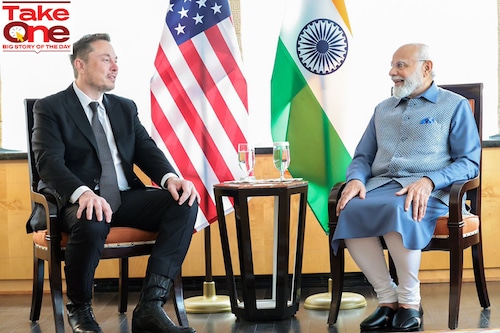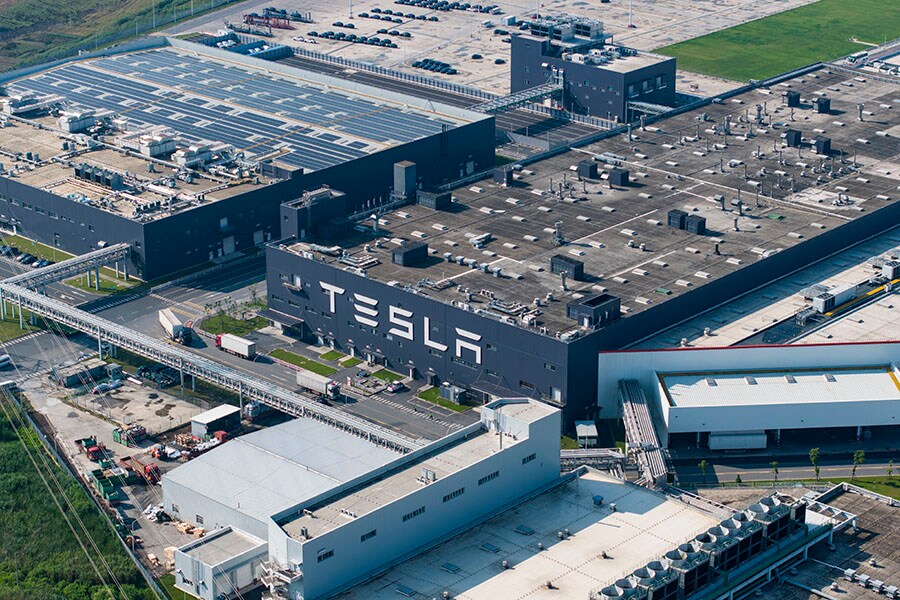From Twitter to Tesla, how Modi's fan Musk is getting ready for big India plans
A year after its standoff with the government over selling mandates, the Tesla founder is gung-ho about entering India and complying with guidelines


Elon Musk and Narendra Modi seem to have hit it off like a house on fire. In their first meeting since Musk bought Twitter in 2022, the billionaire businessman publicly announced that he is a fan of the Indian prime minister and that Tesla’s much-awaited entry into India will happen next year.
“I am confident that Tesla will be in India and will do so as soon as humanly possible," Musk said after his meeting with the PM Modi. Modi is on a three-day state visit to the US, the first such since he took charge in 2014. “I would like to thank the prime minister for his support and hopefully we will be able to announce something in the not-so-distant future."
Musk’s announcement comes a month after senior officials at Tesla flew down to New Delhi to meet with the government to work out plans for setting up operations in India. "We do not want to jump the gun on an announcement but I think it is quite likely that it will be a significant investment in our relationship with India," Musk said after his meeting with Modi.
That’s a far cry from a year ago when Musk had publicly said he would skip making investments to set up manufacturing in India since the electric car maker wasn’t allowed to sell cars, to begin with. It’s still unclear how Tesla intends to start operations in India, but the government had stood firm on its decision that Tesla needed to set up manufacturing in India, and not import from China if it wanted to tap into the Indian market.
Musk had earlier said he’ll likely pick a new Tesla factory location by the end of the year after announcing plans to set up a factory in Mexico earlier this year. “I am actually incredibly excited about the future of India. I think India has more promise than any other large country in the world," the world’s richest man, with a net worth of $246 billion, said.
India is currently the world’s fastest-growing large economy, which means it’s not just Tesla that Musk is focussing on as part of his India plans. Already, the 51-year-old has a presence in India with Twitter, and is now also firming up plans to launch his satellite-based internet service, Starlink, in the country.
Starlink is well-known for providing high-speed internet access to remote locations thanks to the world’s largest constellation of satellites operating in a low orbit around the Earth. “The Starlink internet, which I think can be incredibly helpful for remote or rural villages where they perhaps either may have no access to the internet or the internet is very expensive and slow," Musk said.
Starlink had earlier planned to begin services in India and even began taking pre-bookings in March 2021. That plan fell through after the country’s telecom department sought various approvals, and even asked the company to refund the booking amount. SpaceX, which runs Starlink, has now applied for global mobile personal communication by satellite services (GMPCS) licence to start operations.
Meanwhile, Musk, a self-admitted fan of the Indian PM, has also pointed out that Twitter will continue to comply with the prevailing rules in the country to avoid shutting down. Musk’s stand was in response to former Twitter CEO and co-founder Jack Dorsey’s comments that the Indian government threatened to shut Twitter and raid the houses of its employees unless it complied with orders to restrict accounts that were critical of it during the farmer protests in 2021.
“Twitter does not have a choice but to obey local governments," Musk said. “If we don"t obey local government laws, we will get shut down. So the best we can do is to work close to the law in any given country, it is impossible for us to do more than that. One cannot just apply America to Earth. We will do our best to provide free speech that is possible under the law."
Musk’s stand on Twitter is also significant, considering India has one of the world’s largest penetration of smartphones, and the billionaire businessman has been fixated on monetising the social media giant. India will have a billion smartphone users by 2026, according to Deloitte, much of which will be driven by sales in rural areas, providing a massive opportunity for Twitter to step up its India play.
Even as he firms up Starlink’s India entry in addition to Twitter’s continuing operations in India, all attention has now turned towards Tesla’s entry into India.
A year from its standoff with the government, Tesla is now quite desperate to set up a manufacturing facility, whether that’s in India or South Korea. That’s because the Austin-headquartered automaker wants to take advantage of its position as a cost leader in the global electrification journey even as it struggles with supply constraints.
The move becomes even more relevant considering how incumbents, such as Mercedes, BMW, Hyundai, and Volkswagen, have stepped on the gas on their electrification journey, and, in the process, have drawn away potential buyers from Tesla.
Tesla currently has six manufacturing facilities across the globe, with four in the US. It also has two Gigafactories—a facility that can manufacture cars and batteries—in Shanghai and Berlin. In March, the company confirmed it has identified Mexico to set up another Gigafactory where it intends to produce a next-generation vehicle. The company plans to sell 20 million EVs a year in 2030 from about 1.3 million currently, which would mean a significant ramp-up in assembly plants and battery production.
 Aerial view of Tesla Shanghai Gigafactory on June 2, 2023 in Shanghai, China. Image: VCG via Getty Images
Aerial view of Tesla Shanghai Gigafactory on June 2, 2023 in Shanghai, China. Image: VCG via Getty Images
“If Tesla invests in India, it can change the rules of the game in the premium market," Puneet Gupta, director for automotive forecasting at market research firm S&P Global Mobility had told Forbes India earlier. “Battery is the big component in an electric car, and if Tesla can find a way to localise in India, and with the low-cost structure in the electric vehicle market, it can give a perfect product proposition. There certainly is a potential for a Rs25 lakh to Rs30 lakh car in the electric vehicle market."
Musk himself has been advocating a sub-$30,000 (Rs24.5 lakh) electric vehicle since 2008, but even the cheapest Teslas costs as much as $42,000 (Rs34.5 lakh) in the US. In India, import duties on completely built units are currently around 100 percent. That means a Tesla can’t be available for less than $80,000 (Rs65 lakh), making it unaffordable for millions of Indians, unless the company can find a way to bring the vehicle as a completely knocked down unit (CKU), which attracts 15 percent duties. But that would also mean setting up an assembly unit in India. Local production, however, offers incentives and makes manufacturing cheaper.
With supply chain constraints beginning to eat into Tesla’s timelines—Musk has said the production of its Class 8 EV semi-truck would be dialled down due to supply chain issues—it also helps that India, with its low-cost operating structures, offers an alternative in ramping up production in addition to an economy that’s now expected to be the fastest growing large economy.
“India offers lower labour and manufacturing costs compared to some other countries," Harshvardhan Sharma, head of auto retail practice at Nomura Research Institute, told Forbes India last week. “This could potentially reduce production costs for Tesla and make their vehicles more competitive in terms of pricing. Establishing a manufacturing facility in India would also help overcome supply chain challenges such as long lead times and logistics issues."
On June 14, Musk said limitations in battery supply meant that the automaker will wait until 2024 to increase production of its electric trucks, which were first delivered in December 2022. "So, we"re tentatively aiming for 50,000 units in 2024 for Tesla Semi in North America. And obviously, we"ll expand beyond North America," Musk said on June 13 in Austin.
The supply constraints for its trucks also come at a time when the company has cut prices for some of its Model Y and Model 3 vehicles in the US for the sixth time, in its attempt to take the fight to other automakers who have also been chasing electrification.
“In the current macroeconomic environment, we see this year as a unique opportunity for Tesla," Tesla said in its quarterly earnings. “As many carmakers are working through challenges with the unit economics of their EV programmes, we aim to leverage our position as a cost leader. We are focussed on rapidly growing production, investments in autonomy and vehicle software, and remaining on track with our growth investments."
Globally, automakers, ranging from GM to BMW and Ford, are expected to spend over $500 billion in developing all-electric vehicles from gasoline models over the next several years. GM had, in 2021, said the company would switch to an all-electric fleet by 2035 while Ford had announced plans to go all-electric in Europe by 2030. In India too, automakers from Tata to Mahindra have taken the plunge to develop their models as the government looks to have 30 percent of all vehicles sold in the country to be electric by 2030. Currently, Tata Motors sells over 6,500 units of electric vehicles every month in the country.
By 2030, about 40 to 45 percent of all two-wheelers and 15 to 20 percent of all four-wheelers (passenger vehicles) sold in India will be electric, according to a report by Bain & Co, while the government wants EV penetration to hit 40 percent for buses, 30 percent for private cars, 70 percent for commercial vehicles, and 80 percent for two-wheelers.
It means Tesla knows India remains a key market, both from a manufacturing and a sales point, especially since global economies are now adapting a China plus one strategy. “If Tesla succeeds in producing and offering more affordable models, it could potentially address the affordability concerns in the Indian market," Sharma of Nomura had told Forbes India.
Then there is the potential that India’s recent discoveries in lithium-ion reserves will help in ramping up the critical element central to electric vehicle manufacturing. Globally, a sudden surge in pursuing electric vehicles has meant that battery prices haven’t seen a gradual decline as was expected in 2022, prices for lithium-ion batteries rose by 7 percent, according to Bloomberg NEF. Automotive lithium-ion (Li-ion) battery demand increased by about 65 percent to 550 GWh in 2022, from about 330 GWh in 2021, according to the International Energy Agency. That, despite a 180 percent growth in lithium production compared to 2017.
“In 2022, about 60 percent of lithium, 30 percent of cobalt, and 10 percent of nickel demand was for EV batteries," IEA said in a global EV outlook for 2023. “Just five years earlier, in 2017, these shares were around 15 percent, 10 percent, and 2 percent, respectively. As has already been seen for lithium, mining and processing of these critical minerals will need to increase rapidly to support the energy transition, not only for EVs but more broadly to keep up with the pace of demand for clean energy technologies."
First Published: Jun 21, 2023, 14:41
Subscribe Now